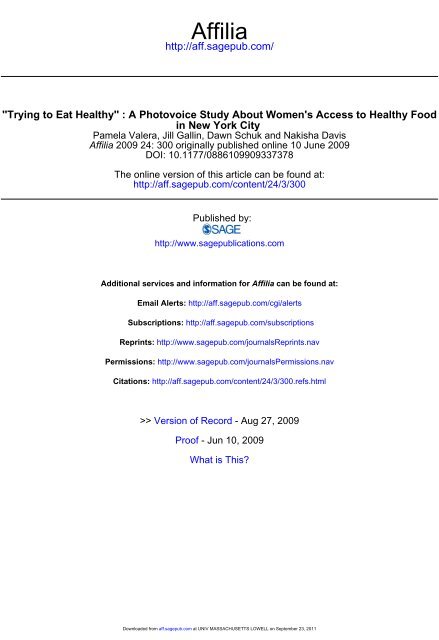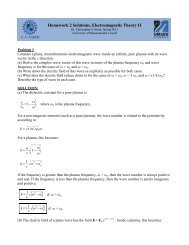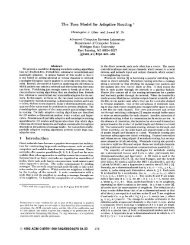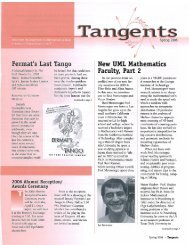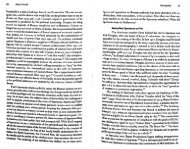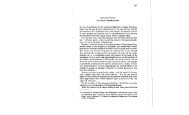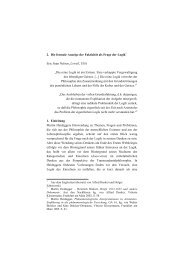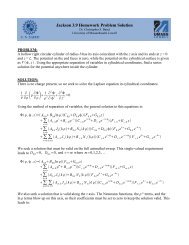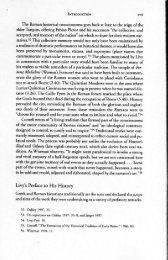Davis, Nakisha, Jill Gallin, Dawn Schuck, and Pamela Valera. 2009.
Davis, Nakisha, Jill Gallin, Dawn Schuck, and Pamela Valera. 2009.
Davis, Nakisha, Jill Gallin, Dawn Schuck, and Pamela Valera. 2009.
Create successful ePaper yourself
Turn your PDF publications into a flip-book with our unique Google optimized e-Paper software.
Affilia<br />
http://aff.sagepub.com/<br />
''Trying to Eat Healthy'' : A Photovoice Study About Women's Access to Healthy Food<br />
in New York City<br />
<strong>Pamela</strong> <strong>Valera</strong>, <strong>Jill</strong> <strong>Gallin</strong>, <strong>Dawn</strong> Schuk <strong>and</strong> <strong>Nakisha</strong> <strong>Davis</strong><br />
Affilia 2009 24: 300 originally published online 10 June 2009<br />
DOI: 10.1177/0886109909337378<br />
The online version of this article can be found at:<br />
http://aff.sagepub.com/content/24/3/300<br />
Published by:<br />
http://www.sagepublications.com<br />
Additional services <strong>and</strong> information for Affilia can be found at:<br />
Email Alerts: http://aff.sagepub.com/cgi/alerts<br />
Subscriptions: http://aff.sagepub.com/subscriptions<br />
Reprints: http://www.sagepub.com/journalsReprints.nav<br />
Permissions: http://www.sagepub.com/journalsPermissions.nav<br />
Citations: http://aff.sagepub.com/content/24/3/300.refs.html<br />
>> Version of Record - Aug 27, 2009<br />
Proof - Jun 10, 2009<br />
What is This?<br />
Downloaded from aff.sagepub.com at UNIV MASSACHUSETTS LOWELL on September 23, 2011
‘‘Trying to Eat Healthy’’<br />
A Photovoice Study About Women’s Access<br />
to Healthy Food in New York City<br />
Affilia: Journal of Women<br />
<strong>and</strong> Social Work<br />
Volume 24 Number 3<br />
August 2009 300-314<br />
# 2009 SAGE Publications<br />
10.1177/0886109909337378<br />
http://aff.sagepub.com<br />
hosted at<br />
http://online.sagepub.com<br />
<strong>Pamela</strong> <strong>Valera</strong><br />
<strong>Jill</strong> <strong>Gallin</strong><br />
Columbia University<br />
<strong>Dawn</strong> Schuk<br />
<strong>Nakisha</strong> <strong>Davis</strong><br />
Sisterlink, New York<br />
Photovoice is a participatory action approach in which individuals use photographs to identify<br />
<strong>and</strong> address issues in their community. The objective of this study was to document the<br />
challenges that low-income women face in accessing healthy food in New York city. Data<br />
were drawn from focus-group interviews with nine low-income women aged 20–45. The<br />
findings indicated that low-income women who live in homeless shelters have less access to<br />
healthy food, such as fresh fruits <strong>and</strong> vegetables, than do other women. They speak of the<br />
broader issue of structural barriers to eating healthy that women in impoverished urban<br />
communities face. Even with these constraints, women are not powerless <strong>and</strong> instead find ways<br />
to exercise personal agency.<br />
Keywords:<br />
food; photovoice; urban life; women<br />
Widespread food insecurity is a growing crisis in New York city. Despite New York<br />
city’s abundant wealth, glamour, <strong>and</strong> opportunities, the number of people who suffer<br />
from hunger <strong>and</strong> food insecurity is staggering. The New York City Coalition Against Hunger<br />
(2005) reported that before the current economic crisis, 1.3 million residents lived in<br />
households in which food was limited <strong>and</strong> scarce, <strong>and</strong> more than 1.7 million New York city<br />
residents had incomes that were below the poverty line of US$15,670—figures that<br />
undoubtedly increased since then. Studies have demonstrated that income inequality may<br />
be linked to hunger, food insecurity, <strong>and</strong> the lack of access to healthy food options (Casey,<br />
Szeto, Lensing, Bogle, & Weber, 2001; Drewnowski & Darmon, 2005; Lynch et al., 2004).<br />
In addition to income inequality, fresh fruits <strong>and</strong> vegetables are scarce in low-income New<br />
York city neighborhoods. Limited access to healthy foods may contribute to various<br />
chronic health problems, including heart disease, stroke, colon cancer, obesity, <strong>and</strong> type<br />
2 diabetes (Gordon, Ghai, Purciel, Talwalker, & Goodman, 2007).<br />
A growing body of scientific literature has shown that neighborhoods with a high<br />
proportion of ethnic <strong>and</strong> racial minorities have fewer healthy food choices <strong>and</strong> less access<br />
to fresh fruits <strong>and</strong> vegetables (Hill, Wyatt, Reed, & Peters, 2003; Kwate, 2008; Lewis et al.,<br />
Authors’ Note: The authors express their gratitude to the participants for the time they spent conducting the<br />
Photovoice project <strong>and</strong> for sharing their views with the staff <strong>and</strong> researchers. Special thanks to Karen Green,<br />
Stephanie Edwards, Rashida Moore, Shelly Pavris, Patricia Perez, Leonora Yeates, <strong>and</strong> Li Wei. Thanks also to<br />
Drs. Joyce Moon-Howard, José A. Bauermeister, <strong>and</strong> Javier Boyas for their constructive criticism on previous<br />
versions of the manuscript.<br />
300<br />
Downloaded from aff.sagepub.com at UNIV MASSACHUSETTS LOWELL on September 23, 2011
<strong>Valera</strong> et al. / ‘‘Trying to Eat Healthy’’ 301<br />
2005; Riley, Glasgow, & Eakin, 2001; Winkler, Turrell, & Patterson, 2006). Studies have<br />
shown that low-income women in predominately African American <strong>and</strong> Latino<br />
neighborhoods experience a greater increase in food insecurity <strong>and</strong> related illnesses than<br />
do middle-income women in predominately Caucasian neighborhoods (Morl<strong>and</strong> &<br />
Filomena, 2007; Powell, Chaloupka, & Bao, 2007). Public health researchers, advocates,<br />
<strong>and</strong> community practitioners have expressed concern that the increase in food insecurity<br />
has contributed to the growing epidemic of obesity <strong>and</strong> diabetes in New York city among<br />
low-income women (Adler, 2006; Food Bank Association, 2007; New York City Coalition<br />
Against Hunger, 2005; Wallace, 2008). Although studies have examined healthy food<br />
choices among low-income women (Inglis, Ball, & Crawford, 2005; Yancey, Lesile, &<br />
Abel, 2006), more studies are needed that vividly capture the challenges that lowincome<br />
women face in accessing healthy foods in their communities. This article reports<br />
the results of a photovoice project—‘‘Trying to Eat Healthy’’—a qualitative study that<br />
captured <strong>and</strong> conveyed the experiences that affect women’s access to healthy foods through<br />
documentary photography.<br />
Photovoice is a research method, based on the principles of critical consciousness theory<br />
(Freire, 1970) <strong>and</strong> feminist theory (Wang & Burris, 1997), which is used in the first stage of<br />
participatory action research. The photographs act as a vehicle for participants to identify<br />
pressing issues (Wang, 1999). Photovoice is unique in that it encourages participants to take<br />
photographs that reflect their surroundings <strong>and</strong> life experiences (Wang, Yi, Tao, &<br />
Carovano, 1998). The visual representations of their experiences allow participants to<br />
mobilize <strong>and</strong> communicate the issues more effectively to policy makers <strong>and</strong> other stakeholders<br />
(Wang, 1999; Wang & Burris, 1997). The ‘‘Trying to Eat Healthy’’ photovoice<br />
project investigated the following questions: Can we afford to eat healthy in New York<br />
city? Under what circumstances are women more likely to experience hunger <strong>and</strong> food<br />
insecurity?<br />
Context <strong>and</strong> Key Participants<br />
Method<br />
Sisterlink is a program of Community Action for Prenatal Care, funded by the New York<br />
State Department of Health AIDS Institute <strong>and</strong> located at the Northern Manhattan Prenatal<br />
Partnership in New York city. The program began in 1999, in Buffalo, <strong>and</strong> includes zip<br />
codes in Brooklyn, the Bronx, <strong>and</strong> northern Manhattan where there were high rates of HIV<br />
seroprevalence among women who give birth <strong>and</strong> high rates of late or no prenatal care. Sisterlink<br />
is designed to reduce adverse birth outcomes, such as mother-to-child HIV transmission<br />
<strong>and</strong> low birth weight, by recruiting high-risk pregnant women <strong>and</strong> linking them to<br />
culturally appropriate prenatal care <strong>and</strong> social support services.<br />
The nine participants, recruited from SisterLink, were mostly ethnic <strong>and</strong> racially<br />
minority mothers aged 20–45—four African American, three Afro-Caribbean, one Caucasian,<br />
<strong>and</strong> one Asian American. The women were predominately from low-income<br />
backgrounds with reported personal annual incomes of less than US$10,000; six were<br />
on public assistance, <strong>and</strong> three were living in homeless family shelters. Their level of education<br />
ranged from some high school to a bachelor’s degree. Only one participant worked<br />
part time; the rest were unemployed. The women’schildrenrangedinagefrom6months<br />
to 16 years.<br />
301<br />
Downloaded from aff.sagepub.com at UNIV MASSACHUSETTS LOWELL on September 23, 2011
302 Affilia: Journal of Women <strong>and</strong> Social Work<br />
Procedures<br />
The data used in the study included field notes prepared during the three focus-group<br />
meetings, transcripts from the focus-group meetings, <strong>and</strong> photographs taken by the participants.<br />
The Photovoice project was part of a community-based participatory research course<br />
conducted from September 2007 through December 2007. This study was the result of a<br />
class project of a master’s of public health student (the second author) <strong>and</strong> a postdoctoral<br />
research fellow (the first author) from a major research institution. Three focus-group sessions,<br />
ranging from 1 to 3 hr, were held in a private <strong>and</strong> comfortable training room. During<br />
the first meeting, the participants were given an overview of the photovoice method; consent<br />
procedures approved by the university’s institutional review board were discussed <strong>and</strong><br />
signed. The participants were informed that a signed release would be required for any<br />
photographs of people, including those younger than age 18.<br />
In addition, the participants were informed that there were at least three additional<br />
sessions <strong>and</strong> that they would receive a disposable camera <strong>and</strong> a US$10 incentive for their<br />
participation. We stressed to the participants how important it was for them to reflect on<br />
their surroundings <strong>and</strong> to use photography to share their life experiences <strong>and</strong> perceptions<br />
about the social problems they faced in their community. Their research assignment, to<br />
be turned in at the second meeting (4 weeks later), was to take photographs that reflected<br />
their experiences with access to healthy food in Central Harlem.<br />
In the first session, the participants discussed concerns that affected their families. The<br />
issues raised questions about safety in the parks; the lack of available men in the area; the<br />
inability to buy fruits <strong>and</strong> vegetables because of their high cost; <strong>and</strong> their concerns about<br />
diabetes affecting their children. The participants began establishing priorities among these<br />
social problems <strong>and</strong> decided to focus on one issue: healthy foods <strong>and</strong> whether they had<br />
access to fresh fruits <strong>and</strong> vegetables. They began to ask each other why it was difficult for<br />
them to access healthy foods in their neighborhood, which resulted in their overall research<br />
question: Can we afford to eat healthy in Central Harlem? The participants were encouraged<br />
to take photographs that reflected the research question. At the end of the first session,<br />
they were instructed to bring their disposable cameras for processing to the SisterLink<br />
office before the next meeting.<br />
During the second session, the group was given their photographs to review. In this<br />
session, each participant was asked to select four to six photographs to discuss in the group.<br />
The researchers used a focus group facilitators’ guide, known as the objective, reflective,<br />
interpretive <strong>and</strong> decisional (ORID) questions (see Governance <strong>and</strong> Local Democracy<br />
Project, 1999, for more information about the ORID method), to facilitate the participants’<br />
thought process. After everyone in the group had described her photographs, several<br />
common themes began to emerge. The third session was used to discuss the strengths <strong>and</strong><br />
challenges of the photovoice project, acknowledge the women’s accomplishments, present<br />
the findings to the group, <strong>and</strong> discuss possible solutions.<br />
Data Analysis<br />
Focus-group protocol. Each focus-group process used a semistructured interview protocol<br />
(Kreuger, 1999; Morgan, 1997) The ORID focus-group discussion method was used<br />
after the participants selected the photographs that most reflected the issue they had identified:<br />
access to healthy food in Central Harlem. The ORID focus-group discussions had<br />
four consecutive stages. First, the participants were asked about the objective of taking<br />
302<br />
Downloaded from aff.sagepub.com at UNIV MASSACHUSETTS LOWELL on September 23, 2011
<strong>Valera</strong> et al. / ‘‘Trying to Eat Healthy’’ 303<br />
pictures. For example, they were asked, ‘‘How many pictures did you take?’’ The probes<br />
included, ‘‘What did you observe?’’ <strong>and</strong> ‘‘How long did it take you to complete your<br />
research assignment?’’ Second, reflective questions were asked to enable the group members<br />
to discuss how they felt about their photographs. For example, the participants were<br />
asked, ‘‘How did you feel when you took that picture?’’ The probes included, ‘‘What was<br />
the most challenging part of taking these pictures?’’ <strong>and</strong> ‘‘How did you decide to take this<br />
picture?’’ Third, interpretive questions were asked to enable the group members to describe<br />
the meaning of their photographs. For example, the participants were asked, ‘‘What would<br />
you say about this picture to someone who is not from your neighborhood?’’ The probes<br />
included, ‘‘What did you achieve by taking this picture?’’ Finally, decisional questions<br />
were asked to enable the group members to respond to the problems of food insecurity <strong>and</strong><br />
limited access to healthy foods. For example, they were asked, ‘‘What possible solutions do<br />
you have to address food insecurity?’’ The probes included, ‘‘What needs to change?’’ <strong>and</strong><br />
‘‘Who should be involved in changing these issues?’’<br />
Coding <strong>and</strong> Construction of the Theme<br />
The discussions were digitally recorded <strong>and</strong> transcribed before the final meeting, <strong>and</strong> the<br />
text that was generated from the transcribed data was read in full <strong>and</strong> subject to content<br />
analysis (Miles & Huberman, 1984). We analyzed the data from the focus-group discussions<br />
to ensure interrater reliability <strong>and</strong> used quotations from the transcripts to exemplify<br />
the themes that emerged from the data. The photographs were discussed, evaluated, <strong>and</strong><br />
selected by the participants. During the final meeting, we conducted a member check, in<br />
which the participants validated our synthesis of the data (Miles & Huberman, 1984).<br />
Results<br />
Early in the study, it became evident to us that the participants shared a high level of<br />
knowledge <strong>and</strong> awareness of nutrition. The participants often referred to the food pyramid<br />
guide <strong>and</strong> were aware that they should eat more foods from the bottom part of the pyramid<br />
(vegetables <strong>and</strong> whole grains) <strong>and</strong> less from the top (meat). When prompted, they<br />
communicated their knowledge that they knew how to eat healthy. However, this level<br />
of knowledge did not translate into healthy eating because they could not afford to buy<br />
fresh fruits <strong>and</strong> vegetables. By applying photovoice as a method to view the social <strong>and</strong><br />
economic circumstances that affected their lives, the participants were able to go beyond<br />
commiserating about the issues, what Wang (2003) referred to as social action through<br />
photovoice. Through dialogue <strong>and</strong> critical analysis of the photographs, opportunities to<br />
think about potential solutions emerged from the discussions. Three major themes were<br />
identified (a) the lack of access to healthy foods, (b) the participants’ emergent awareness<br />
of their local environment, <strong>and</strong> (c) the process of becoming change agents. In keeping with<br />
the goals of participatory action research, the participants achieved a consensus on the<br />
themes <strong>and</strong> the content of the study (Wang, 2003).<br />
The Lack of Access to Healthy Foods<br />
The participants described their lack of access to healthy foods, or food insecurity, their<br />
regular reliance on food pantries <strong>and</strong> soup kitchens to feed their families, <strong>and</strong> their struggle<br />
303<br />
Downloaded from aff.sagepub.com at UNIV MASSACHUSETTS LOWELL on September 23, 2011
304 Affilia: Journal of Women <strong>and</strong> Social Work<br />
each month to have enough money to buy groceries. They discussed how they sought food<br />
pantries <strong>and</strong> soup kitchens in their neighborhood to survive. As the participants engaged in<br />
the process of documenting their lives, they discovered that their individual experiences of<br />
food insecurity did not differ from each other, but how they managed the process of events<br />
varied by the severity of their food insecurity.<br />
The degree of food insecurity depended on their living conditions. Several women with<br />
children who were living in shelters talked about the struggles of not having enough food<br />
for their children. These women learned to cut back on food or relied on food pantries <strong>and</strong><br />
soup kitchens to provide consistent meals. For others, gaining access to healthy foods was<br />
an ordeal, <strong>and</strong> healthy foods were often difficult to afford in their neighborhood. Overall,<br />
the women reported that they had to make frequent changes in the quality <strong>and</strong> quantity of<br />
their diets because of their limited food stamp budgets.<br />
Access to good-quality affordable food was a related theme. The participants viewed the<br />
high price of fresh fruits <strong>and</strong> vegetables as a constant roadblock to healthy lifestyles. For<br />
example, several participants talked about the desire to buy fruits <strong>and</strong> vegetables<br />
but reflected on the challenges of having to choose between other basic needs, as in the<br />
following comments:<br />
I want to buy healthy foods, but I got to pay the rent, pay the bills, <strong>and</strong> pay the baby-sitter. My<br />
one job is not going to do that. How do I live? (African American woman with three teenage<br />
children)<br />
As women, we need sanitary napkins, soap, <strong>and</strong> deodorant. And we can’t afford to buy it if we<br />
got to spend money on expensive foods like this. (Afro-Caribbean woman with one child)<br />
The participants struggled with the ability to buy healthy foods to feed themselves <strong>and</strong><br />
their children. The awareness of the high cost of fruits <strong>and</strong> vegetables in their local<br />
supermarkets surprised some participants. Referring to a photograph (see Figure 1), one<br />
participant spoke about the high cost of tomatoes. She stated, ‘‘I was shocked, eight<br />
tomatoes for $3.99—that’s outrageous for tomatoes.’’<br />
Several participants felt frustrated by the limited options in their local supermarkets:<br />
Bad. Angry sometimes? This stuff. I have to cook with it, just to get the nutrients stuff that<br />
I need to better me. But, oh man! That’s a lot of money. I just look at [it] <strong>and</strong> leave it alone.<br />
I need them, but I can’t buy them. (Afro-Caribbean woman with one child)<br />
I have two small children that I am trying to feed properly. It’s easy to open up a can of ravioli<br />
<strong>and</strong> give that to my kids. Is it healthy for them? Does it have all the vitamins <strong>and</strong> things to help<br />
them develop? No, it does not. My daughter she’s a vegetable fanatic, thank God, but some<br />
days I can’t buy her those strawberries because they’re $4.99. Before I had kids, I wasn’t one<br />
of those who likes to eat strawberries; that wasn’t my thing. If I had a taste for strawberries,<br />
I would get myself some strawberry preserves in a jar <strong>and</strong> get over myself. But, I don’t want<br />
to give my children all of that processed artificial sugar. She wants to eat a carton of<br />
strawberries, by all means eat them, but not at $4.99. ‘‘We can’t do it today, sweetie. Not<br />
today.’’ (African American woman with two children)<br />
The participants also stated that they must buy food that clearly does not have any<br />
nutritional value. They noted that they ‘‘just want to be able to cook a decent meal for their<br />
children.’’ Referring to a photograph (see Figure 2), another participant said, ‘‘I wanted to<br />
304<br />
Downloaded from aff.sagepub.com at UNIV MASSACHUSETTS LOWELL on September 23, 2011
<strong>Valera</strong> et al. / ‘‘Trying to Eat Healthy’’ 305<br />
Figure 1<br />
Sky-High Prices! For What?<br />
Figure 2<br />
Fish Is for the Rich<br />
305<br />
Downloaded from aff.sagepub.com at UNIV MASSACHUSETTS LOWELL on September 23, 2011
306 Affilia: Journal of Women <strong>and</strong> Social Work<br />
Figure 3<br />
No Vegetable Cart<br />
give my kids some fish. The salmon is $6.99 a pound, but I told them we cannot afford it’’<br />
(African American women with two children)<br />
The participants also emphasized that food insecurity was not a phenomenon that only<br />
they experienced, but one that other women in their neighbored experienced as well. One<br />
participant referred to a photograph of her neighbor’s grocery cart (see Figure 3) that had no<br />
vegetables:<br />
My reaction toward it, it was like WOW! So I asked her if she needed any help. ‘‘No baby, I’m<br />
OK,’’ said the woman. She was explaining to me, ‘‘I just got to do this every month trying to<br />
put money aside you know.’’ (African American woman with two children)<br />
All too often, food choices were limited or simply unaffordable. The participants identified<br />
another subtheme related to food insecurity: the challenge of living on a limited food<br />
stamp budget. They emphasized that purchasing fresh fruits <strong>and</strong> vegetables locally was<br />
unrealistic with the limited food stamp benefits they received each month. Living on a food<br />
stamp budget in New York city is extremely difficult; the nation’s average food stamp benefit<br />
is US$196 per month (U.S. Department of Agriculture, Food <strong>and</strong> Nutrition, Office of<br />
Analysis, Nutrition, <strong>and</strong> Evaluation, 2005), but most participants were receiving an average<br />
of US$98 per month to feed a family of four. They also reported that they often did not<br />
receive their food stamp benefits at the scheduled date each month; some waited for weeks<br />
for their food stamps to arrive.<br />
Referring to the photograph in Figure 3, the participants noted that other women were<br />
also facing economic hardships. Participants frequented food banks, food pantries, <strong>and</strong><br />
306<br />
Downloaded from aff.sagepub.com at UNIV MASSACHUSETTS LOWELL on September 23, 2011
<strong>Valera</strong> et al. / ‘‘Trying to Eat Healthy’’ 307<br />
soup kitchens at the end of each month. Other participants also reflected on the challenges<br />
of not getting enough assistance to pay for basic needs, such as toiletries <strong>and</strong> feminine<br />
hygiene products, <strong>and</strong> said that when their food stamp benefits run short, they use whatever<br />
remaining cash they have to cover the difference <strong>and</strong> have no cash left to purchase basic<br />
items:<br />
Because we’re not getting enough cash. I’m not working. I got to buy food clothing, toiletries,<br />
<strong>and</strong> personal stuff. The amount of money I’m getting in cash can’t buy all that stuff. Food<br />
stamps can only buy food. They can’t buy toiletries or any of that stuff. So, then I don’t have<br />
enough money to buy my toiletries. (Afro-Caribbean woman with two children)<br />
Some participants said that being forced to eat on a limited food stamp budget was the<br />
cause of developing health problems. What they <strong>and</strong> their families eat or lack in their diets<br />
ultimately leads to poor health outcomes (Lynch et al., 2004). Several participants commented<br />
on such health concerns as high blood pressure, diabetes, <strong>and</strong> chronic illness.<br />
Emergent Awareness of the Local Environment<br />
Through their own discussions <strong>and</strong> by sharing similar stories with each other, the participants<br />
voiced frustration <strong>and</strong> anger about coming to terms with this awareness of their circumstances<br />
within the context of their community. The participants ascribed their<br />
increased awareness of the conditions that perpetuated food insecurities, such as financial<br />
disparities (i.e., poverty), to the ways in which advertising campaigns <strong>and</strong> marketing techniques<br />
strongly encourage customers to buy <strong>and</strong> eat unhealthy foods:<br />
I was taking pictures of some of the things that were healthy <strong>and</strong> some of the things that I’ve<br />
noticed that they were [practically] giving away. When you go to the supermarket <strong>and</strong> when<br />
you see a can of soda for 25 cents <strong>and</strong> a bottle of water for $2, sometimes your income will<br />
force you to buy the unhealthy food. (African American woman with two children)<br />
Even at some of the restaurants, if you buy a slice of pizza, instead of them giving you a bottle<br />
of water for free, they’ll give you a can of soda for free. (White woman with three children)<br />
Perhaps what was most important is that the participants were aware that food marketing<br />
strongly influenced their food choices, as shown in the photograph in Figure 4. When asked<br />
which groups are affected by this advertising, many of them had concerns for the wellbeing<br />
of their children <strong>and</strong> the risks to their own health:<br />
When I’m feeding my kid, you know, the sugar, the cereal that got all this sugar, rather than the<br />
Rice Cheks or something that’s a bit more expensive, there’s a whole lot more stuff to worry<br />
about. We pay for it at the end <strong>and</strong> so do our children. There’s a big picture. (African American<br />
with four children)<br />
Why does it matter? So, maybe we can live longer. I mean I don’t want to be here where I<br />
cannot totally do anything by myself. But, I think having a heart attack at age 37 is a big disgrace.<br />
Like 37, I’m dying from a heart attack or even at risk of having a heart attack. At 37!<br />
(African American woman with three children)<br />
307<br />
Downloaded from aff.sagepub.com at UNIV MASSACHUSETTS LOWELL on September 23, 2011
308 Affilia: Journal of Women <strong>and</strong> Social Work<br />
Figure 4<br />
Diabetes for Sale<br />
Through critical reflections on their surroundings that restricted their choices to eat healthier,<br />
the participants reported that they were fearful that their food choices would increase<br />
the risk of heart diseases <strong>and</strong> the likelihood of their children developing type 2 diabetes<br />
mellitus. They agreed that local supermarkets <strong>and</strong> food producers go out of their way to<br />
promote unhealthy foods. However, when they turned away from local supermarkets<br />
because the food is too expensive <strong>and</strong> shop at local corner stores, they reported that they<br />
are still sold unhealthy food. The participants noted that the option of making wise food<br />
choices is not typically available to them.<br />
Access to cheap foods because of a limited food stamp budget was identified as the only<br />
option that many participants <strong>and</strong> other people in their neighborhood have. The photograph<br />
in Figure 5 shocked some participants that corner stores were allowed to sell debilitated<br />
turkey parts.<br />
People buy this stuff? (all)<br />
Yeah, they can’t afford not to. No, that’s not the local store, that’s between Broadway <strong>and</strong> Amsterdam.<br />
You see how beat up the turkey is; that’s why it’s so cheap, but people buy it. So many scary<br />
turkey parts. ... Scary, but it looks like food, <strong>and</strong> you don’t feel hungry [afterward], but for fruits,<br />
you know, you pay like $10 <strong>and</strong> still make you feel hungry. (Asian woman with one child)<br />
The participants’ food choices are based on what they can afford. The participants noted<br />
that eating ‘‘so many scary turkey parts’’ may have disastrous <strong>and</strong> unhealthy outcomes, at<br />
308<br />
Downloaded from aff.sagepub.com at UNIV MASSACHUSETTS LOWELL on September 23, 2011
<strong>Valera</strong> et al. / ‘‘Trying to Eat Healthy’’ 309<br />
Figure 5<br />
So Many Scary Turkeys<br />
least their family would feel satiated after the meal. Because the availability of affordable<br />
food is limited, some make poor food choices, not because they eat without thinking about<br />
the unhealthy consequences. On the contrary, they think about food constantly <strong>and</strong> worry<br />
about their next meal. Because fast-food restaurants are readily accessible <strong>and</strong> affordable to<br />
low-income women <strong>and</strong> their children, some participants relied on them to feed their families<br />
a three-course meal. In this neighborhood, the participants noted the prevalence of<br />
fast-food restaurants within a two-block radius: KFC, Dominos, Popeye’s, <strong>and</strong> McDonalds.<br />
The incessant advertising, marketing, <strong>and</strong> selling of the poorest quality foods imaginable in<br />
their local environment were a real concern for the participants. The participants noted that<br />
poor people are often blamed by doctors <strong>and</strong> the general public for their poor diet <strong>and</strong> their<br />
children’s poor food intake:<br />
I have doctors knocking at my door because according to their chart, my son is about<br />
150 pounds overweight. He’s in the obese category. (African American woman with three<br />
teenage boys)<br />
My daughter, she is 3 years old. I have problems with the weight lady bugging me about my daughter<br />
not putting on the pounds that she’s supposed to have. (Afro-Caribbean woman with one child)<br />
The Process of Becoming Community Change Agents<br />
The participants were encouraged to reflect on what they could do to minimize the difficulties<br />
of maintaining a nutritious diet. Several strategies were used in the photovoice<br />
309<br />
Downloaded from aff.sagepub.com at UNIV MASSACHUSETTS LOWELL on September 23, 2011
310 Affilia: Journal of Women <strong>and</strong> Social Work<br />
project to support such efforts. First, we focused on a set of framing questions (i.e., How do<br />
you survive? What needs to change?), which gave them the opportunity to examine their<br />
experiences more critically. Second, the use of photography required the participants constantly<br />
to interact with the issue <strong>and</strong> to begin to think about solutions to address the phenomenon<br />
of food insecurity. Several strategic themes emerged: shopping outside the<br />
neighborhood may be less expensive, cooking at home may be cheaper, <strong>and</strong> increasing the<br />
awareness of the community-at-large <strong>and</strong> policy makers of women’s lack of access to<br />
healthy <strong>and</strong> affordable foods in New York city.<br />
Shopping outside their neighborhood was one strategy that the participants used to minimize<br />
the food insecurities they experienced. The participants said that they often traveled<br />
great distances to other boroughs to buy healthy, affordable foods:<br />
I have to travel to Astoria, Queens ...I have to buy my fruits <strong>and</strong> vegetables there because I<br />
can’t afford to in Harlem. The Pathmark here kills my budget. In Astoria, they have 99 centsper-pound<br />
red peppers <strong>and</strong> green peppers ...In Harlem, peppers are $2.99 a pound or more;<br />
[for that amount] you could buy four peppers in Astoria. At Pathmark in Harlem, red, orange<br />
peppers are $5 a pound. (African American woman with two children)<br />
They have this supermarket that is in the Bronx, it’s called Food Bazaar, <strong>and</strong> it’s great because<br />
I get my money’s worth. We call it a service store. We would leave from Manhattan <strong>and</strong> go to<br />
the Bronx <strong>and</strong> take a cab, we got bags like crazy. You save because then I could get four items<br />
that you know you could buy for one price in Pathmark they cost this price. (White woman<br />
with three children)<br />
Even when there were several local supermarkets in their neighborhood, the participants<br />
traveled long distances to buy affordable food at other supermarkets. They reported that<br />
access to public transportation (a bus, subway, or taxi) afforded them the opportunity to<br />
purchase food outside their neighborhood.<br />
‘‘Homemade is cheaper’’ was another theme that many participants viewed as an important<br />
aspect of minimizing food insecurity. One participant explained that cooking at home<br />
is economical <strong>and</strong> has several benefits: choosing the exact menu <strong>and</strong> choosing to include<br />
healthier <strong>and</strong> tastier ingredients. Referring to the photograph in Figure 6, she emphasized<br />
the importance of cooking at home to save money:<br />
Homemade is better, tastier, <strong>and</strong> a cheaper price. My husb<strong>and</strong> said if you count my job because<br />
you know we have to do everything, cooking, the cleaning, everything we have to do there, it’s<br />
priceless. Because we have to prepare this food the whole morning for the lunch, this is cheaper<br />
than the commercials. (Asian woman with one child)<br />
This participant said that she travels to Chinatown to buy most of her groceries. Two<br />
plates of dumplings can feed a family of four, she noted, costing her approximately<br />
US$5 to purchase the ingredients. Several participants stated that the preparation time for<br />
home-cooked meals was a major drawback. However, the women who lived in homeless<br />
family shelters did not have the benefit of cooking in their homes, <strong>and</strong> for them, easier<br />
access to unhealthy foods than to healthy foods was a reality. For these women, the problem<br />
was not limited to access to food, because cooking is an added challenge; they described the<br />
difficulty of cooking a healthy meal on a hot plate when no oven or stove is provided.<br />
Aside from the lack of cooking materials, the participants also raised the issue of safety.<br />
Referring to the photograph in Figure 7, some participants were fearful that their children<br />
310<br />
Downloaded from aff.sagepub.com at UNIV MASSACHUSETTS LOWELL on September 23, 2011
<strong>Valera</strong> et al. / ‘‘Trying to Eat Healthy’’ 311<br />
Figure 6<br />
Homemade Is Cheaper<br />
would get electrocuted because electrical plugs were near the kitchen sink. The compact<br />
refrigerator (size 1.7 cubic feet) that is typically found in most shelter dwellings does not<br />
have the capacity to hold even 1 gallon of milk. For several participants, these hardships<br />
made eating out more of a necessity than a choice. Thus, changing the living conditions<br />
of women in homeless family shelters emerged as a major theme.<br />
Discussion<br />
The findings from our study indicate that low-income women in low-income neighborhoods<br />
are offered higher end supermarket prices, which makes it more challenging for<br />
women <strong>and</strong> their children to eat healthier. Barriers to eating healthy foods may increase the<br />
likelihood that their children will develop chronic health conditions, such as obesity <strong>and</strong><br />
type 2 diabetes mellitus. The participants’ concerns were consistent with the findings of<br />
other studies that have demonstrated the association between the lack of access to healthy<br />
foods <strong>and</strong> type 2 diabetes (Adams, Grummer-Strawn, & Chavez, 2003; Horowitz, Colson,<br />
Hebert, & Lancaster, 2004). Our findings also support what other researchers have found:<br />
Neighborhoods with a high proportion of low-income African Americans <strong>and</strong> Latinos have<br />
limited access to affordable healthy foods (Gordon et al., 2007; Kaufman & Karpati, 2007).<br />
The study reported here is the first to demonstrate the usefulness of photovoice to<br />
examine the challenges to eating healthy foods in New York city. Photovoice gave the<br />
participants the opportunity to examine their community critically through their lived<br />
experiences. Through focus-group discussions <strong>and</strong> using photographs as evidence of<br />
women’s plight, the participants documented their own stories about the challenges in<br />
accessing healthy foods. Unlike the traditional focus-group approach to capturing data, the<br />
photovoice method engaged the participants in the entire process of research, including<br />
dissemination of their findings. With photovoice, researchers could use focus-group<br />
311<br />
Downloaded from aff.sagepub.com at UNIV MASSACHUSETTS LOWELL on September 23, 2011
312 Affilia: Journal of Women <strong>and</strong> Social Work<br />
Figure 7<br />
Home Sweet Home<br />
discussions to reflect on the pictorial data collected by participants. Both researchers<br />
<strong>and</strong> members of a community leave these discussions with rich data <strong>and</strong> a desire for<br />
social change. Moreover, photovoice offers a unique tool for underst<strong>and</strong>ing a social<br />
problem from the perspectives of research participants that will inform quantitative<br />
data but, what is more important, may lead to culturally appropriate solutions because<br />
the participants are involved in the collection, interpretation, <strong>and</strong> dissemination of the<br />
findings.<br />
For instance, the participants recommended that increasing food stamp benefits (to<br />
include cash) to pay for organic <strong>and</strong> healthier foods would decrease food insecurities. In<br />
addition, providing food vouchers to use at farmers’ markets may help them afford to eat<br />
healthier <strong>and</strong> provide better access to fresh fruits <strong>and</strong> vegetables. They also reported that the<br />
limited food stamp program, the poor food supplies, the unkempt corner stores, <strong>and</strong><br />
inadequate shelter accommodations ought not to be ignored.<br />
As a result of this study, two important action plans were implemented. The participants<br />
wrote letters to their local assembly members to communicate the findings to policy<br />
makers. They also presented their photovoice project at the second annual Conference<br />
on Health Disparities at Teachers College, Columbia University.<br />
Although our research was one of only a h<strong>and</strong>ful of studies to use photovoice methods<br />
for participatory action research, it was not without its limitations. One limitation was the<br />
small sample of nonr<strong>and</strong>omly selected women from one agency in Central Harlem. Some<br />
participants were living in homeless family shelters with a limited ability to cook their own<br />
meals. As a result, generalizations cannot necessarily be made to low-income women who<br />
do not reside in homeless family shelters. However, given the remarkable burden of food<br />
insecurity that low-income women face, further examination of the chronic health disparities<br />
<strong>and</strong> health risks for this population from low-income neighborhoods is an important<br />
area for social work <strong>and</strong> public health research.<br />
312<br />
Downloaded from aff.sagepub.com at UNIV MASSACHUSETTS LOWELL on September 23, 2011
<strong>Valera</strong> et al. / ‘‘Trying to Eat Healthy’’ 313<br />
Conclusion<br />
As a participatory action research project, ‘‘Trying to Eat Healthy’’ helped to promote<br />
what Wang (2003) referred to as social action through photovoice, the process by which<br />
individuals become change agents <strong>and</strong> take a proactive approach to finding solutions to<br />
social problems by fostering critical underst<strong>and</strong>ing, dialogue, <strong>and</strong> collective action. This<br />
photovoice project built on the assets, strengths, <strong>and</strong> resources of the community. A collaborative<br />
partnership was established, <strong>and</strong> the knowledge of the researchers <strong>and</strong> participants<br />
was integrated for the mutual benefit of both. The project was one way to shed light on the<br />
topic of food insecurity in a city that is filled with healthy foods, wealth, <strong>and</strong> abundance.<br />
References<br />
Adams, E. J., Grummer-Strawn, L., & Chavez, G. (2003). Food insecurity is associated with increased risk of<br />
obesity in California women. Journal of Nutrition, 133, 1070-1074.<br />
Adler, M. (2006). Hunger on the rise in New York city. Retrieved March 15, 2008, from http://www.npr.org/templates/story/story.php?storyId¼670421<br />
Casey, P. H., Szeto, K., Lensing, S., Bogle, M., & Weber, J. (2001). Children in food-insufficient, low-income<br />
families: Prevalence, health, <strong>and</strong> nutrition status. Archives of Pediatrics & Adolescence Medicine, 155,<br />
508-514.<br />
Drewnowski, A., & Darmon, N. (2005). Food choices <strong>and</strong> diet costs: An economic analysis. Journal of Nutrition,<br />
135, 900-904.<br />
Food Bank Association. (2007). Anti-hunger policy platform for New York state <strong>and</strong> city 2007. Retrieved April<br />
25, 2008, from http://www.foodbankassocnys.org/hunger-in-ny.cfm#session.homeurl#files/anti-hunger-policy-<br />
2007-2012.pdf<br />
Freire, P. (1970). Pedagogy of the oppressed. New York: Seabury.<br />
Gordon, C., Ghai, N., Purciel, M., Talwalker, A., & Goodman, A. (2007). Eating well in Harlem: How available is<br />
healthy food? New York: New York City Department of Health <strong>and</strong> Mental Hygiene.<br />
Governance <strong>and</strong> Local Democracy Project. (1999). Technology of participation: Basic group facilitation methods,<br />
level one: Manual for course participants. Manila, Philippines: United States Agency for International<br />
Development.<br />
Hill, J. O., Wyatt, H. R., Reed, G. W., & Peters, J. C. (2003). Obesity <strong>and</strong> the environment: Where do we go from<br />
here? Science, 299, 853-855.<br />
Horowitz, C. R., Colson, K. A., Hebert, P. L., & Lancaster, K. (2004). Barriers to buying healthy foods for people<br />
with diabetes: Evidence of environmental disparities. American Journal of Public Health, 94, 1549-1554.<br />
Inglis, V., Ball, K., & Crawford, D. (2005). Why do women of low socioeconomic status have poorer dietary<br />
behaviors than women of higher socioeconomic status? A qualitative exploration. Appetite, 45, 334-343.<br />
Kaufman, L., & Karpati, A. (2007). Underst<strong>and</strong>ing the sociocultural roots of childhood obesity: Food practices<br />
among Latino families of Bushwick, Brooklyn. Social Science <strong>and</strong> Medicine, 67, 2177-2188.<br />
Kreuger, R. A. (1999). Focus groups: A practical guide for applied research. Thous<strong>and</strong> Oaks, CA: SAGE.<br />
Kwate, N. O. A. (2008). Fried chicken <strong>and</strong> fresh apples: Racial segregation as a fundamental cause of fast food<br />
density in black neighborhoods. Health & Place, 14, 32-44.<br />
Lewis, L. B., Sloane, D. C., Nascimento, L. M., Diamant, A. L., Guinyard, J. J., Yance, A., et al. (2005). African<br />
Americans’ access to healthy food options in South Los Angeles. American Journal of Public Health, 95, 668-<br />
673.<br />
Lynch, J., Smith, G. D., Harper, S., Hillemeier, M., Ross, N., Kaplan, G. A., et al. (2004). Is income inequality a<br />
determinate of population health? Part I. A systematic review. Milbank Quarterly, 82, 5-99.<br />
Miles, M. B., & Huberman, A. M. (1984). Qualitative data analysis: A sourcebook of new methods. Beverly Hills,<br />
CA: SAGE.<br />
Morgan, D. L. (1997). Planning focus groups. Thous<strong>and</strong> Oaks, CA: SAGE.<br />
Morl<strong>and</strong>, K., & Filomena, S. (2007). Disparities in the availability of fruits <strong>and</strong> vegetables between racially<br />
segregated urban neighborhoods. Public Health Nutrition, 10, 1481-1489.<br />
313<br />
Downloaded from aff.sagepub.com at UNIV MASSACHUSETTS LOWELL on September 23, 2011
314 Affilia: Journal of Women <strong>and</strong> Social Work<br />
New York City Coalition Against Hunger. (2005). The hunger squeeze: Skyrocketing costs, sinking wages increases<br />
hunger in New York City: Annual New York City Hunger Survey. Retrieved May 25, 2008, from http://www.<br />
nyccah.org/files/2005hungerreport.doc<br />
Powell, L. A., Chaloupka, F. J., & Bao, Y. J. (2007). The availability of fast-food <strong>and</strong> full-service restaurants in the<br />
United States: Associations with neighborhood characteristics. American Journal of Preventive Medicine, 33,<br />
S240-S245.<br />
Riley, K. M., Glasgow, R. E., & Eakin, E. G. (2001). Resources for health: A socio-ecological intervention for<br />
supporting self-management of chronic conditions. Journal of Health Psychology, 6, 693-705.<br />
U.S. Department of Agriculture, Food <strong>and</strong> Nutrition Service, Office of Analysis, Nutrition, <strong>and</strong> Evaluation.<br />
(2005). Characteristics of food stamp households: Fiscal year 2004. Retrieved May 28, 2008, from http://<br />
www.fns.usda.gov/ora/MENU/Published/SNAP/FILES/Participation/2004Characteristics.pdf<br />
Wallace, B. C. (Ed). (2008). Toward equity in health: A new global approach to health disparities. New York:<br />
Springer.<br />
Wang, C. C. (1999). Photovoice: A participatory action research strategy applied to women’s health. Journal of<br />
Women’s Health, 8, 185-192.<br />
Wang, C. C. (2003). Using Photovoice as a participatory assessment <strong>and</strong> issue selection tool: A case study with the<br />
homeless in Ann Arbor. In M. Minkler & N. Wallerstein (Eds.), Community-based participatory research for<br />
health (pp. 180-196). San Francisco: Jossey-Bass.<br />
Wang, C. C., & Burris, M. (1997). Photovoice: Concept, methodology, <strong>and</strong> use of participatory needs assessment.<br />
Health Education <strong>and</strong> Behavior, 24, 369-387.<br />
Wang, C. C., Yi, W. K., Tao, Z. W., & Carovano, K. (1998). Photovoice as a participatory health promotion<br />
strategy. Health Promotion International, 13, 75-86.<br />
Winkler, E., Turrell, G., & Patterson, F. (2006). Does living in a disadvantaged area entail limited opportunities to<br />
purchase fresh fruit <strong>and</strong> vegetables in terms of price, availability, <strong>and</strong> variety? Findings from the Brisbane<br />
Food Study. Health & Place, 12, 741-748.<br />
Yancey, A. K., Leslie, J., & Abel, K. (2006). Obesity at the cross-roads: Feminist <strong>and</strong> public health perspectives.<br />
Signs, 31, 425-443.<br />
<strong>Pamela</strong> <strong>Valera</strong>, PhD, is a postdoctoral research fellow, HIV Center for Clinical <strong>and</strong> Behavioral Studies, Columbia<br />
University/New York State Psychiatric Institute, 1051 Riverside Drive, Unit 15, New York, NY 10032; e-mail:<br />
pv2155@columbia.edu.<br />
<strong>Jill</strong> <strong>Gallin</strong>, MPH, is a supervisor of a school based program, Columbia University School of Public Health, 722<br />
West 168th Street, New York, NY 10032; e-mail: jh230@columbia.edu.<br />
<strong>Dawn</strong> Schuk, MA, is the executive director of Sisterlink, 127 West 127th Street, Room 309, New York, NY<br />
10027; e-mail: <strong>Dawn</strong>hollynyc@aol.com.<br />
<strong>Nakisha</strong> <strong>Davis</strong> is the program coordinator of Sisterlink, 127 West 127th Street, Room 309, New York, NY 10027;<br />
e-mail: davisnakisha@yahoo.com.<br />
314<br />
Downloaded from aff.sagepub.com at UNIV MASSACHUSETTS LOWELL on September 23, 2011


